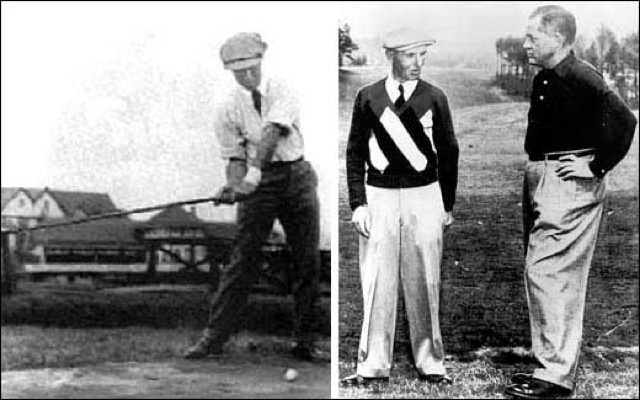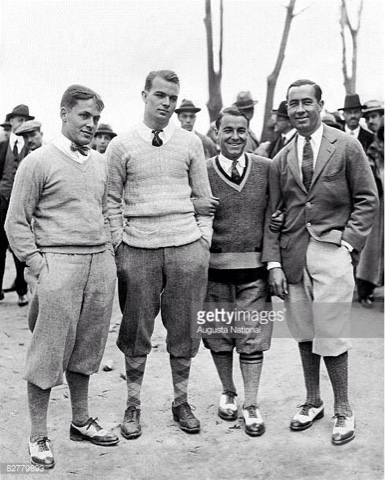In his introduction to his book
Golf is my Game, Bobby Jones, in my opinion, provided about the best preface to learning the game of golf that can be found anywhere. Now I realize I am biased in my appraisal because I happen to believe that Bobby Jones was the greatest golfer of all time. I don't intend to argue that point, because it's futile anyway, and Bobby himself would not be impressed if I were to in any way tear down another great player in an effort to build him up. Suffice it to say, his record speaks quite adequately for itself.
What I think impresses me the most about Bobby Jones was that he accomplished so much in the game, so early, while essentially golfing part time. While winning thirteen Major championships by the time he was twenty eight, Bobby also earned a degree in Mechanical Engineering from Georgia Tech, a degree in literature from Harvard, and, after one year of law school, passed the Georgia State Bar to earn the right to practise law. No small feat on its own, but to do all this while taking time away from his studies to run around beating the best golfers in the world is truly remarkable, to say the least.
But back to Bobby's introduction. As might be expected, Bobby began by giving us the purpose of the book. He wrote: "I have written this book because I thought I could help golfers of all classes to play better and to get more enjoyment from their play." That was the purpose of the book, plain and simple; to help golfers of every level play better and have more fun.
Bobby never claimed to be a golf teacher. And, therefore, dealt with that immediately. He wrote:
"I have never tried to teach golf, having always been on the receiving end of any such exchange, but I have spent many years trying to learn something about the game. At times I have thought that I had learned pretty well, but I always found more to learn."
Bobby, like Ben Hogan, understood that we never stop learning in this game. Or at least we never should stop learning. So, Bobby preferred to consider himself a successful student of the game rather than a teacher. With respect to teaching, Bobby went on to write:
"Teaching anything requires a great deal more than knowledge of the subject. It is one thing to possess knowledge or the ability to perform--quite another to be able to impart that knowledge or skill. I am sure that I do not even know all the qualities needed by a teacher, although I have read several treatises on the subject. It is enough for me to know that I have no right to pretend to be one.
On the other hand, in golf at least, I can claim to have been a fairly successful learner, and I more than half suspect that any golfer may rightfully attribute more if whatever skill he may possess to his own ability to learn than to the ability of someone else to teach. At any rate, I have written my book as a learner, rather than as a teacher. I am not ambitious to teach teachers to teach, but if I can help learners to learn, I shall consider my reward sufficient."
I think this sends a very good message to those who might desire to become teachers, or who already consider themselves to be teachers. They should never forget that a successful student can attribute as much of his success to his ability to learn as you can to your ability to teach. I think that's a good, and realistic way to approach the business of trying to teach others in this game.
Bobby now goes on to discuss how difficult it is to learn the game. Once again, I think it's a good message for students and teachers alike. He wrote:
"It is a popularly accepted notion that golf is a difficult game to teach and a difficult game to learn. It doesn't have to be either. It is all a question of the level of skill to which the learner aspires, or upon which the teacher intends to insist. Considered objectively, it is quite obviously a very simple matter to propel a ball with a stick across some specially prepared ground and into a hole which is of sufficient size to accommodate it by a good margin. Simple, that is, provided there is no limit set upon the time or the number of strokes required. The matter is further simplified by reason of the fact that many earnest people have spent a lot of time, thought, and money upon the development of clubs and balls ideally suited to the process, and of greenskeeping methods which assure that the field of play will be more than reasonably well conditioned.
I must insist, therefore, that one who sets out with the object of learning to play golf well enough to get both pleasure and benefit from the pursuit of the game has a very good, if not one hundred per cent, chance of success, provided he sets for himself exactly this goal, and no other.
It seems to me that there are two quite reasonable ways in which a person may take his golf. If he has the time and the inclination to do so, he may set out to give the game a proper amount of serious study and practice with a view towards elevating himself considerably beyond the average-golfer class; or if he has only a very limited amount of free time, as many have, he may be content to knock around with his regular foursome, who play about as he does, in search of a little fun. But it will not do to mix the two, especially to hang the ambitions of the first man upon the labours of the latter."
Golf is definitely a game that can and should be enjoyed by everyone. But students and teachers must decide just what the goal is. Is the goal to become a better than average player; or is it just to be able to have some fun knocking it around with your buddies? And, if the goal is to become a good player, is the student prepared to put in the time and effort required? It's a fair and necessary question that must be answered if the ultimate goal of enjoying the game is to be reached.
I remember Harvey Penick talking about teaching a woman to get the ball in the air so she could go out on the course with her husband. When she got that ball airborne she was so delighted, and Harvey had goosebumps. I had a similar experience helping some girls from work before a work tournament. It was pure joy to see them hitting the ball in the air for the first time. They weren't going to break a hundred, but they were happy as clams, and so was I.
Sadly, I see all too often, teachers promising results to students that they can't possibly deliver. We see it constantly in books, magazines, and on the internet. Buy this training aid, or this golf club, or read this article, or take this course, and you'll be hitting it like Henrik Stenson. Not only is it false advertising, it hurts the student by setting him up to fail because of unreasonable expectations. Why does the golf industry persist in this kind of snake oil salesmanship?
We can all enjoy this game if we are realistic about what it is we hope to achieve. And, if we are realistic, we can have lots of fun for a lifetime. Chances are we'll never hit it anything remotely like Henrik. But we can still have a passion for playing this wonderful game.







